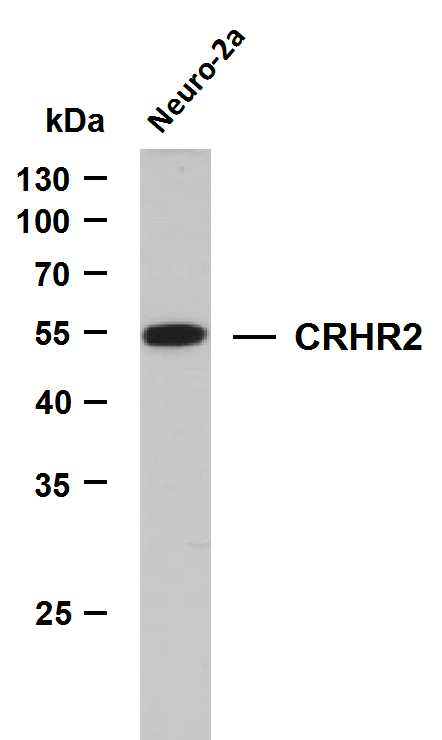CRHR2 (PTR1205) mouse mAb
- Catalog No.:YM4731
- Applications:WB;IF;ELISA
- Reactivity:Human;Mouse;Rat;
- Target:
- CRHR2
- Gene Name:
- CRHR2 CRF2R CRH2R
- Protein Name:
- Corticotropin-releasing factor receptor 2 (CRF-R-2) (CRF-R2) (CRFR-2) (Corticotropin-releasing hormone receptor 2) (CRH-R-2) (CRH-R2)
- Human Gene Id:
- 1395
- Human Swiss Prot No:
- Q13324
- Mouse Swiss Prot No:
- Q60748
- Immunogen:
- Synthesized peptide derived from human CRHR2 AA range: 50-150
- Specificity:
- This antibody detects endogenous levels of CRHR2 protein.
- Formulation:
- PBS, 50% glycerol, 0.05% Proclin 300, 0.05%BSA
- Source:
- Mouse, Monoclonal/IgG2b, kappa
- Dilution:
- WB 1:500-2000. IF 1:100-500. ELISA 1:1000-5000
- Purification:
- Protein G
- Concentration:
- 1 mg/ml
- Storage Stability:
- -15°C to -25°C/1 year(Do not lower than -25°C)
- Molecular Weight(Da):
- 47kD
- Observed Band(KD):
- 47kD
- Background:
- corticotropin releasing hormone receptor 2(CRHR2) Homo sapiens The protein encoded by this gene belongs to the G-protein coupled receptor 2 family, and the subfamily of corticotropin releasing hormone receptor. This receptor shows high affinity for corticotropin releasing hormone (CRH), and also binds CRH-related peptides such as urocortin. CRH is synthesized in the hypothalamus, and plays an important role in coordinating the endocrine, autonomic, and behavioral responses to stress and immune challenge. Studies in mice suggest that this receptor maybe involved in mediating cardiovascular homeostasis. Alternatively spliced transcript variants encoding different isoforms have been described for this gene.[provided by RefSeq, Jan 2011],
- Function:
- G-protein coupled receptor for CRH (corticotropin-releasing factor), UCN (urocortin), UCN2 and UCN3. Has high affinity for UCN. Ligand binding causes a conformation change that triggers signaling via guanine nucleotide-binding proteins (G proteins) and down-stream effectors, such as adenylate cyclase. Promotes the activation of adenylate cyclase, leading to increased intracellular cAMP levels.
- Subcellular Location:
- 0
- June 19-2018
- WESTERN IMMUNOBLOTTING PROTOCOL
- June 19-2018
- IMMUNOHISTOCHEMISTRY-PARAFFIN PROTOCOL
- June 19-2018
- IMMUNOFLUORESCENCE PROTOCOL
- September 08-2020
- FLOW-CYTOMEYRT-PROTOCOL
- May 20-2022
- Cell-Based ELISA│解您多样本WB检测之困扰
- July 13-2018
- CELL-BASED-ELISA-PROTOCOL-FOR-ACETYL-PROTEIN
- July 13-2018
- CELL-BASED-ELISA-PROTOCOL-FOR-PHOSPHO-PROTEIN
- July 13-2018
- Antibody-FAQs
- Products Images

- Whole cell lysates were separated by 12% SDS-PAGE, and the membrane was blotted with anti-CRHR2 (PTR1319) antibody. The HRP-conjugated Goat anti-Mouse IgG(H + L) antibody was used to detect the antibody. Lane 1: Neuro-2a



